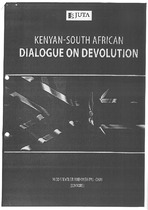| dc.description.abstract | In a radical break with its past, democratic South Africa established a system of devolution that was confirmed in the 1996 Constitution. In reaction to a system of highly centralised government that had seen the abuse of power, spatial inequality and underdevelopment, Kenya has also opted for devolution. This system was embodied in the 2010 Constitution and implemented with the establishment of 47 counties after the general elections in March 2013. Devolution lies at the heart of Kenya’s new constitutional dispensation and provides a means of addressing past injustices. The Kenyan Constitution largely copied the structure, approach and principles of provincial and local government from South Africa. Since the Kenyan system is still in the process of being fully implemented, Kenyan-South African Dialogue on Devolution compares the two systems with reference to their legal provisions. Comparing how the two systems have functioned is more difficult. However, the principal value of this comparison at this stage lies in the lessons that Kenya can learn from South Africa’s 21 years of experience of devolution as Kenya proceeds with establishing its system: what routes to follow and what pitfalls to avoid. Kenyan-South African Dialogue on Devolution includes South African and Kenyan chapters on the reasons for devolution; the levels, number, size and character of devolution units; the demarcation of devolution units; political structures; powers and functions; finances; metropolitan governance; intergovernmental relations; marginalised groups; and transitional arrangements. This book is the first to discuss and compare the Kenyan and South African systems at length, and will be of value to other African countries that have embarked on devolution or decentralisation with the aim of curbing the centralised abuse of power and promoting political stability and development. | en_US |

